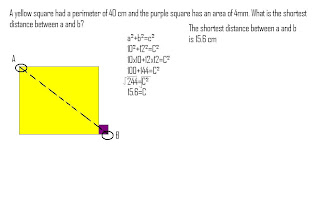On Monday, I was 10 minutes late. So I came in knowing nothing, but I asked a couple of my fellow students and I think I know now.
So, when i came in Mr. Harbeck had a multiplication chart on the smart board.
Then he talked about perfect squares.
The multiplication chart should look like this:

Then he made perfect squares with them,
The squares are perfect because the number is whole, if it has a decimal then it wouldn't be.

These are the perfect squares.

Then the homework.
The homework was to make a perfect squares chart.
It looks like this:


The second homework was this:
well, I think the first one is because it has equal sides.


I think that's all we did. :)
I'm really sorry if there are any mistakes, I'm pretty sure there are.
Well, time to pick the next scribe and I pick
Mellisa B.
 Above is a man named Pythagoras. He invented the "Pythagorean Thereom". He has also found out that the earth is round and that the solar system doesn't revolve around the earth, but the sun! This greek man was also a philosopher and a teacher.
Above is a man named Pythagoras. He invented the "Pythagorean Thereom". He has also found out that the earth is round and that the solar system doesn't revolve around the earth, but the sun! This greek man was also a philosopher and a teacher.




















 HOMEWORK:
HOMEWORK:

















